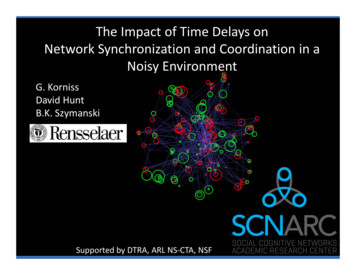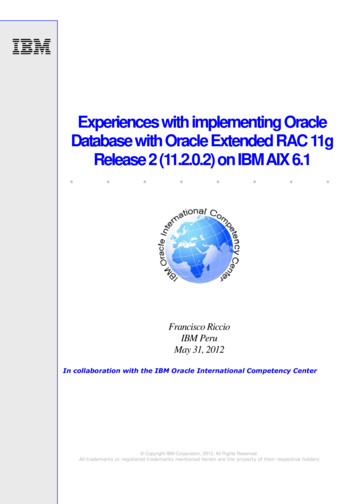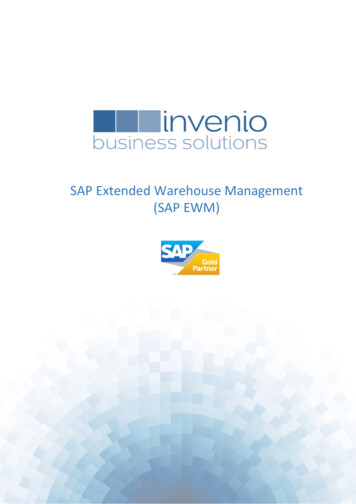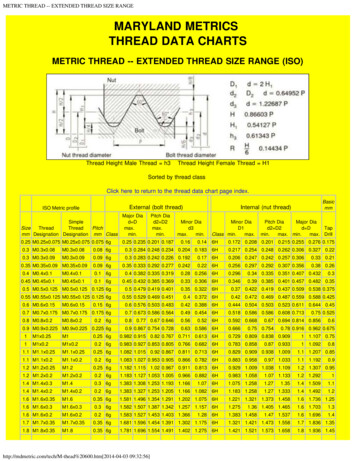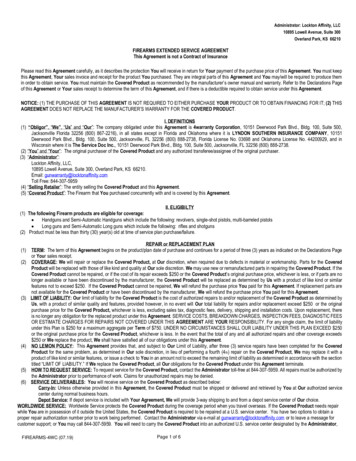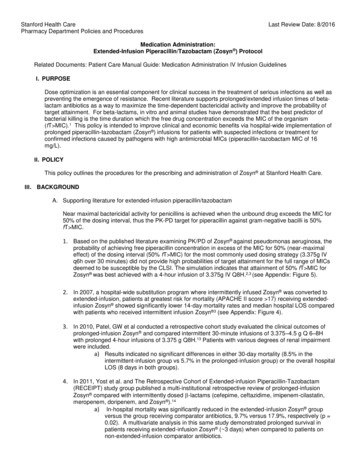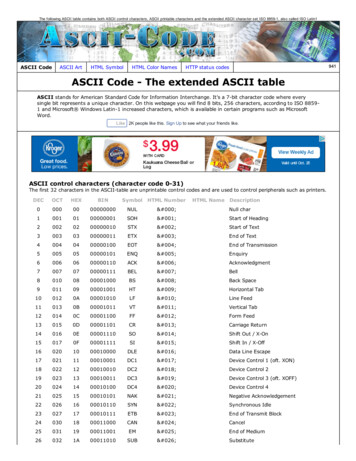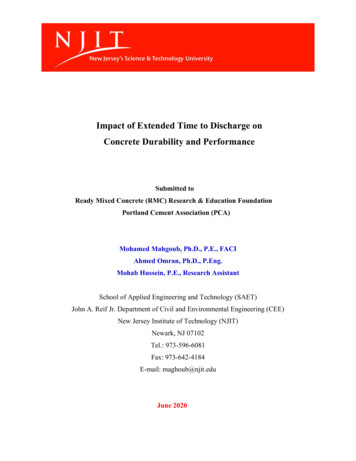
Transcription
Impact of Extended Time to Discharge onConcrete Durability and PerformanceSubmitted toReady Mixed Concrete (RMC) Research & Education FoundationPortland Cement Association (PCA)Mohamed Mahgoub, Ph.D., P.E., FACIAhmed Omran, Ph.D., P.Eng.Mohab Hussein, P.E., Research AssistantSchool of Applied Engineering and Technology (SAET)John A. Reif Jr. Department of Civil and Environmental Engineering (CEE)New Jersey Institute of Technology (NJIT)Newark, NJ 07102Tel.: 973-596-6081Fax: 973-642-4184E-mail: maghoub@njit.eduJune 2020
EXECUTIVE SUMMARYEvery year, a substantial amount of ready mixed concrete is returned to concrete plants fordisposal due to many reasons, such as excessive slump loss during transport, surplus productionand trial batches. It is estimated that the amount of concrete waste is approximately 3% of totalproduction (Obla et al., 2007), and with increasing use of concrete, the generation of such wasteconcrete is also expected to increase. One of the main reasons for rejecting a great number oftruckloads of concrete every year is due to the strict accordance to the 90-minute time limit. Thisis derived from ACI 318-19, section 26.5.1.1 (d), which states, “Ready-mixed and site-mixedconcrete shall be batched, mixed and delivered in accordance with requirements of ASTM C94 orASTM C685” (2019). ASTM C94 section 12.7 states, “Discharge of concrete shall be completedwithin 1½ hours after the introduction of mixing water to the cement and aggregates, or theintroduction of the cement to aggregates” (ASTM C94/C94M, 2018). It further states that, “Thislimitation may be waived” providing additional evaluation information. However, a considerablenumber of truckloads of concrete are still rejected owing to this time limit. As traffic and roadcongestion in urban environments has gotten progressively worse, this rule has unnecessarilyenlarged the construction cost and become more difficult to meet. When concrete stays in themixing truck longer than necessary, it must be disposed resulting in construction and demolitionwaste, increased greenhouse gas emissions, and increases costs to the suppliers and contractors.This research was supported and funded by the Ready Mixed Concrete (RMC) Research& Education Foundation and Portland Cement Association (PCA) to investigate how extendedtime to discharge affects the durability and performance of the concrete load. The experimentalresults of this project can be utilized to identify the durability mechanisms most effected by mixingconcrete for longer times than is currently allowed. The results presented herein can be used toupdate current specifications and guidelines that can allow the concrete suppliers and contractorsto extend the concrete time to discharge up to 150 minutes.Representative and standard concrete mixture designs were selected. The mixtures wereprocured, batched, and poured at a local ready-mix concrete supplier to mimic typical fieldconstruction conditions. Sample specimens to examine impact of time to discharge on strength anddurability were obtained at batching and 60, 90, 120, and 150 minutes after batching. The plasticconcrete properties including air content, slump, and temperature were also obtained at thoseintervals. Extended set retarding admixture was added as needed during mixing to maintain theworkability of the concrete without altering the mixture design. Hardened concrete tests such ascompressive strength, freeze-thaw, and surface resistivity were performed. The results obtainedfrom this study indicate that the concrete time to discharge had no significant impact on the freshproperties, surface resistivity, and freeze-thaw durability up to 150 minutes. As a result of thisresearch, the current discharge time limits and specifications are determined to be conservativeand should be reexamined.2 Page
TABLE OF CONTENTSCHAPTER 1: INTRODUCTION4A. Background4B. Project Objectives and Scope5CHAPTER 2: LITERATURE REVIEW7CHAPTER 3: CASTING AND TEST PROCEDURES9A. Material Properties and Source9B. Mixture Design10C. Mixture Casting12D. Fresh Concrete Test Results12E. Hardened Concrete Test Results15F.16Compressive Strength TestingG. Surface Resistivity Testing18H. Freeze-Thaw Testing19CHAPTER 4: CONCLUSIONS25ACKNOWLEDGEMENT27REFERENCES283 Page
CHAPTER 1: INTRODUCTIONA. BackgroundAn estimated 3% of ready mixed concrete produced in the United States is returned toconcrete plants every year, based on 2006 estimate (Obla et al., 2007). Much of this concrete isdiscarded as waste or washed out to reclaim the aggregates used in the system. This waste resultsin landfilling of hardened concrete, contaminated washout water, substantial disposal, cost, andincreased greenhouse gasses due to additional transportation and production of concrete. Reducingthe amount of concrete that is returned to the ready mix facility will significantly improvesustainability within the concrete industry by preventing unnecessary landfilling of material andreducing use of scarce water resources to wash aggregates reclaimed from waste concrete.One of the main reasons concrete is rejected and then returned to a ready mix facility isbecause of what is known as the 90-minute rule. This rule, supported by many state highwayassociations and building codes, as well as the national standards governing body of the AmericanSociety for Testing and Materials (ASTM), notes that concrete must be discharged from theconcrete mixing truck within 90 minutes after the mixing of the materials (cement, water, andaggregates) has begun (Prasittisopin and Trejo, 2015 and ASTM C94/C94M, 2018).The 90-minute time limit was invoked in the original version of ASTM C94, published in1935. It is assumed that this was inserted to protect the quality of the typical concrete mixturesproduced at that time with the applicable materials and production methods. It is presumed thatthe intent was to ensure that excessive water was not added to a load that could negatively impactits quality.Production methods and concrete materials used have changed considerably since 1935. Itis also true that concrete was generally produced close to the project in 1935 and the average haultime has increased considerably since then – several reasons have been stated. There are a widerange of mixtures and project conditions (including weather) applicable and there is no assurancethat 90 minute limit on delivery is protective of all these situations. In some ambient conditions,concrete quality (without excessive re-tempering) can be retained for periods longer than 90minutes. In this case, acceptable quality is rejected for lack of conformance to an arbitrary timelimit. There are mixtures or ambient conditions where 90 minutes is too long to retain the requiredquality.If the concrete producer is informed about the expected time the mixture will be held in themixer before it will be discharged, the producer will then have different options available toprovide concrete for that delivery time stated when concrete is ordered, within some reasonabletolerance.Regardless of the time limit, ASTM C94/C94M (2018) has provisions that permit concretemixtures to be adjusted with water or admixtures in transit or at the job site. The primary restrictionis that the quantity of water added should not exceed that established for the mixture as designedfor its intended performance characteristics.4 Page
The traffic in urban environments and movement of ready-mix facilities away from citycores have increased the delivery time for concrete trucks, increasing the likelihood that concretewill be rejected then returned to the facility. Advances in concrete technology, including chemicaladmixtures that alter fresh concrete properties and extend setting times, may make this time limitunnecessary.An increase to the 90-minute time to discharge limit will prevent good quality freshconcrete from being returned to ready-mix concrete facilities reducing the amount of wastematerial and contaminated water produced by these facilities and reducing overall operationalcosts. The research outlined in this report will be used to examine if extended time to discharge,up to 150 minutes, will negatively impact the long-term durability of concrete mixtures.B. Project Objectives and ScopeWorkability of concrete is the ability of the concrete to flow through formwork and aroundrebar, and to be consolidated such that voids do not form within the bulk system and a good bondwith the rebar. The most common method of measuring workability is by measuring the slump ofthe concrete, a test in which fresh concrete is placed in a mold and allowed to “slump” down asthe mold is lifted off. One of the objectives of this research project is to determine the impact ofincreased time to discharge on concrete workability. Those measurements are important to be ableto measure the mixtures ability to consolidate in a large open space and also to create good bondsand flow around rebar, according to ASTM Standards, at regular intervals throughout the mixingperiod up to 150 minutes. The results will provide a baseline for understanding how significant theimpact of increased time to discharge is on concrete workability.Air entraining admixtures are added to concrete mixtures to create small air pockets withinconcrete that allows for water within the system to expand without causing internal stresses, andsubsequent cracking, to form in the concrete. Additional time to discharge may actually cause airentrainment to be mechanically removed out of the system by the agitation caused during mixing.Air entrainment and temperature during concrete mixing are the most effective parameters ofprotecting concrete from freeze-thaw deterioration that can occur in outdoor severe coldenvironments (Kosmatka and Wilson, 2016). Hence, the air content and concrete temperature ofeach concrete mixture were measured at regular intervals throughout the mixing period.Reductions in air entrainment, peak temperatures and temperature gradients over time wererecorded to evaluate the impact of increased time to discharge on concrete air entrainment.Concrete strength is an important factor to ensure the adequacy of strength that is requiredfor design and assess the overall quality of concrete. The concrete strength specimens weresampled at various mixing length intervals up to 150 minutes and tested for 28 days, and 56 dayscompressive strength after casting to determine the impact of mixing duration on overall strength,as well as strength development. Compressive strength testing was performed at New JerseyInstitute of Technology’s High Performance Concrete Laboratory in Colton Hall at John A. ReifJr. Civil and Environmental Engineering Department. In addition to strength, freeze-thawdurability can be measured by exposing concrete samples to rapid and continuous cycles offreezing and thawing and continuously assessing the quality of the specimens over the duration ofthe test. The freeze-thaw durability testing was performed on samples casted at various intervals5 Page
during mixing up to 150 minutes. Finally, surface resistivity, which is a test method that can beused to assess a material’s resistance to chloride penetration, and subsequent resistance to rebarcorrosion was performed. This test method involves using a 4-point Wenner probe to quicklyassess the electrical resistivity of a concrete sample. The results were correlated to chloridepenetration resistance using existing protocols (Nassif, et al, 2015). The results from thedischarged mixture after 60 minutes was used as the baseline for comparison with the othermixtures.By completing all aforementioned objectives, the lengths of time to discharge, changes inworkability, temperature, air content, and freeze-thaw results were correlated to understand howthese various indicators may be able to be used to assess long-term durability and performance ofconcrete systems as well as recommend durability mechanisms and which fresh properties aremost affected by extending time to discharge lengths. This work will result in helpful guidance forstate highway agencies and concrete producers on the impact of employing longer time todischarge on concrete.This research is Phase 2 of a multi-phased research project carried out by the Concrete IndustryManagement (CIM) program at School of Applied Engineering and Technology (SAET), NewJersey Institute of Technology (NJIT). The project has started in 2015 in an effort to evaluate thestrict 90-minute time limit and propose any changes based on field and lab tests. Phase 1 was titled“Evaluation of the 90-Minute Rule as an Acceptance Criteria Considering Current ConcreteMixture Design Technology and Mixture Constituents”. Phase 1 studied fresh concrete propertiesalong with hardened concrete properties including compressive, tensile, and flexural strengths.The first phase of the research project was funded by the New Jersey Chapter of AmericanConcrete Institute (NJACI) and the completed report was submitted on April 9, 2017 (Mahgouband Ramanna, 2017).The Principal Investigator, Dr. Mohamed Mahgoub has been asked by several organizationsto present the finding of the first phase of this study. The Concrete and Concrete AggregateCommittee C09 of the American Society for Testing and Materials (ASTM) is in the process ofballoting the 90-minute time limit research recommendations. The details of the presentations andreports are listed in the references.6 Page
CHAPTER 2: LITERATURE REVIEWPrevious work has examined the impact of time to discharge on strength and workabilityof fresh concrete. These results have shown that increased time to discharge can lead to improvedcompressive strengths due to the evaporation of mixing water (Kirca et al., 2002). Improvedcompressive strengths are often considered positive for construction projects. However, theevaporation of water during mixing can also result in decreased workability, poor consolidation,and decreased a
aggregates) has begun (Prasittisopin and Trejo, 2015 and ASTM C94/C94M, 2018). The 90-minute time limit was invoked in the original version of ASTM C94, published in 1935. It is assumed that this was inserted to protect the quality of the typical concrete mixtures produced at that time with the applicable materials and production methods. It is presumed that the intent was to ensure that .
